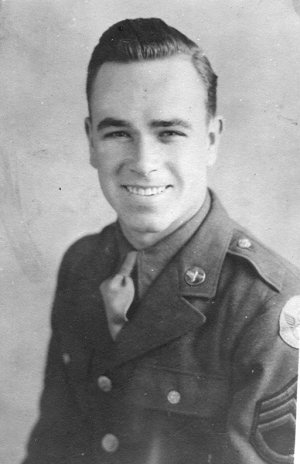World War II Veterans Book: Ralph Eugene McAdams
An Excerpt
Ralph Eugene McAdams was born October 2, 1923.
Father: John Dixie McAdams.
Mother: Maude (Boydston) McAdams.
Wife: Tommy Lee (Box) McAdams.
Date of marriage: March 10, 1950.
Children: Andrew McAdams, Sara McAdams, David McAdams.
Brother: Royce McAdams.
Sisters: Bonnye Lee Phillips, Virginia Varnell.

Ralph McAdams volunteered to serve his country. While working near Bristol, Tennessee he joined the US Army Air Corps and was inducted on May 12, 1942 at Richmond, Virginia. When he was honorably discharged on October 1, 1945, he had advanced from the rank of private to the rank of technical sergeant.
After indoctrination and basic training, Ralph was sent to Scott Field, Illinois to become a radio operator. He successfully completed radio school and was sent to gunnery school to train to shoot the .50 caliber machine guns that were part of the defensive weapons aboard most bombers.
After about a year of continuous course work, Ralph joined eight other young men in California to crew a B-24 heavy bomber. In autumn of 1943 he and the other crew members were ordered to the European war zone. They flew the southern route across the Atlantic, which routed them first to Brazil for the cross-ocean flight. They arrived in Ascension for refueling and headed up the African coast around Spain, and landed in England. There Ralph and his crew were assigned to the 576th Bomb Squadron, 392nd (Heavy) Bomb Group. The 392nd was based at Wendling Station 118, in Norfolk.
In the last few weeks of December 1943, headed by its pilot, Lieutenant George E. Jones, Ralph and his B-24 crew flew training missions to prepare themselves for their first combat assignment. It was popular for the crew to name their plane and have the name and corresponding artwork painted on the side. Ralph’s B-24, number 42-94772, had no name, and was identified only by its aircraft number painted on the tail. When asked why no name had been adopted for the plane, Ralph said that the crew could not agree on the same name!
On January 21, 1944, Ralph and his crew flew their first combat mission. In addition to his job as radio operator, McAdams participated as a “floater”, a crew member who also manned one of the .50 caliber machine gun turrets to protect against German fighter attacks.
Odds were against surviving 25 missions, the required number before being rotated out of combat, but trained crew airmen were needed so badly that the Army Air Corps raised the number to 30, and then to 35. Ralph McAdams flew an incredible 37 missions before his luck ran out. On July 7, 1944, the 392nd Bomb Group was ordered to fly Mission 127. The target was Bernburg, deep in the heart of Germany and heavily defended by antiaircraft artillery (flak). The flak that day was vicious above the target, and German fighter aircraft swarmed the American bombers. Ralph’s plane was shot down by a German FW 190. When he and seven other crewmen safely bailed out they were taken prisoner and the copilot was killed. That same day the 392nd lost five aircraft, and 45 men including McAdams, did not return to England. Of those, 22 were killed.
Excellent records were kept and maintained by the Air Corps units during and immediately following the war. Many interested individuals, including family members of crewmen, worked diligently to maintain detailed records of the young Americans who went to war. Through those efforts, a detailed history of what Ralph Eugene McAdams and his B-24 crewmates experienced during the war has been preserved. The following are from excerpts of published reports of missions flown by McAdams:
- Missing Aircrew Report: #07371 Aircraft: #42-94772 (no nickname): Pilot Jones reported in a questionnaire that he had given a bail out order and the engineer had gone to the waist section to see that all members jumped through the aft hatch, that the navigator and bombardier had jumped through the nose wheel doors opening; and that he, the co-pilot, and Radio Operator (Ralph McAdams) went through the bomb bay door area.
- January 20, 1944: Unexploded shells came into our plane behind George (pilot) going through the armor plate on the upper Martin turret, almost getting Bodoh (engineer). The shell went on out behind McAdams on the right side of the plane.
- February 20, 1944: The mission for this day . . . and crash landed . . . . T/Sgt. McAdams had a deep cut over his left eye that was later sewed up at the base hospital.
- April 29, 1944: T/Sgt. McAdams’ crew had a tough mission and McAdams had to play medic when his co-pilot was badly wounded.
- July 7, 1944 (day that McAdams and crew were shot down): Second Lieutenant Thomas wrote . . . we were hit in the #3 engine and it wouldn’t feather. After we slid out of formation, 14 fighters really worked us over, but finally left. We limped down to lower altitude and kept losing altitude until bailout. Soon after we were hit, fire started streaming back from #3 towards the fuselage. We finally got out . . . but it wasn’t but a little while before it was back burning good . . . . George gave us the bailout number.
McAdams spent the next ten months at Stalag Luft IV, a German prisoner of war camp located north of Berlin. In April 1945 the Russian Army was approaching the camp from the east. The German guards, anxious not to be taken prisoners by the Russians, evacuated all of the POWs and began traveling westward to surrender to the Americans or the British. Ralph and the other prisoners walked for weeks with their guards, both equally anxious to reach the western Allies. For Ralph, it would mean liberation and freedom; for the German guards it would also mean freedom, but in a different sense. Russian captivity would mean execution, or if one was lucky, years in a Siberian labor camp. Finally, in the first week of May, Ralph and the other POWs reached the British Army lines near the Dutch border.
After liberation, McAdams returned to the states, and on October 1, 1945 he received his honorable discharge. Ralph had spent three years and five months of his youth insuring our freedom.
Medals awarded: Distinguished Flying Cross, Purple Heart Medal, Air Medal with five Oak Leaf Clusters, Prisoner of War Medal, American Campaign Medal, European-African-Middle Eastern Campaign Medal with a Bronze Battle Star (for air combat), World War II Victory Medal, Aircrew Member Wings, Aerial Gunner’s Badge.
Ralph Eugene McAdams left his hometown community near Ider to serve his country. He now makes his home in Taylors, South Carolina.
